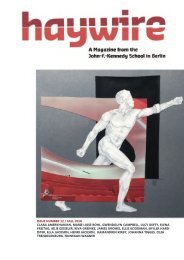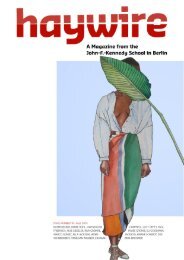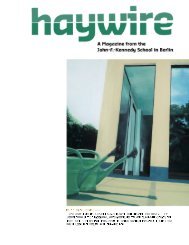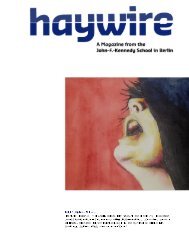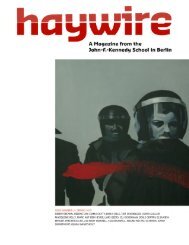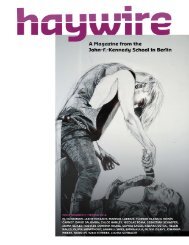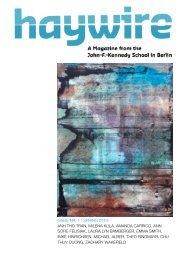Haywire Issue 4 Fall 2014
- No tags were found...
Create successful ePaper yourself
Turn your PDF publications into a flip-book with our unique Google optimized e-Paper software.
glo-Saxon kenning permeates the text, which Heaney<br />
directly translates as “bone-cage” (101). The exceeding<br />
strength of bones, almost unbreakable, protect<br />
animal’s organs. A deeper message imparts itself<br />
through the word’s pairing with “cage”. Cages protect,<br />
but also trap the objects/subjects placed within.<br />
In this case the “bone-cage” imprisons Beowulf’s<br />
soul so it will not soar away into the great unknown.<br />
Similarly, a mysterious presence alluded to by another<br />
kenning makes an appearance. Earlier when the<br />
Geats arrive in Denmark they cross the “sea-lanes”<br />
(17). The lengths this great warrior goes to to defeat<br />
evil abound in this tale, however, to avoid repeating<br />
the same words and sounds multiple times, different<br />
words are compounded to create a new one.Instead<br />
of simply saying ocean, it becomes a “sea-lane”.<br />
Separately the words are weak, yet together they are<br />
mighty.<br />
Extreme use of alliteration closes the gap between<br />
the old English and the modern English version.<br />
Almost all the language, despite its translation,<br />
has poetic tendencies. Beowulf’s introduction by<br />
“Wulfgar […] a Wendel chief renowned as a warrior,<br />
well known for his wisdom” (25). Even this character<br />
with his minuscule role in the context of the novel receives<br />
the honor of alliteration and assonance. Such<br />
devices in the spoken style also make the segments<br />
easy to remember as they contain a rhythm and flow<br />
which floats off the lips. Later to portray the<br />
bravery of Ecgtheow’s son he is extolled as “excelling<br />
himself/ in daring and danger, until the<br />
day arrived when he had to come face to face with the<br />
dragon” (163). The alliteration of “d”, a<br />
harsh consonant proves Beowulf’s strength and agility<br />
of mind as an equal match for the beast.<br />
As with Wulfgar, repetition of the letter “d” creates a<br />
simple way to memorize the worthy warrior’s many<br />
merits. Employing this device can also add layers of<br />
sound to contribute to a scene. At Beowulf’s funeral<br />
a great pyre is lit by arrows: “The shaft hit home.<br />
Feather-fledged, it finned the barb of flight” (209).<br />
The alliteration of “f” creates the fizzle sound of fire<br />
in the background of the story. Before the arrow sets<br />
the pyre of aflame, no “f” sounds are used, but in the<br />
“shaft”, which is already burning. As soon as it ignites<br />
the wooden grave, however, suddenly flames<br />
and alliteration spring up everywhere. To dramatize<br />
HAYWIRE <strong>Issue</strong> 4 <strong>Fall</strong> <strong>2014</strong><br />
Photography by Avery<br />
Swarthout, 11d<br />
31








